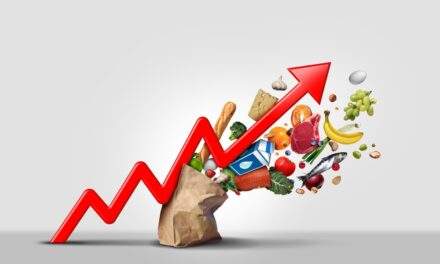$57…
That’s the cost to feed a family of six at Chick-fil-A, based on my recent experience.
And we weren’t getting crazy; just four kid’s meals, a Southwest Chicken Salad and a chicken sandwich.
I was sticker shocked.
When did we go from $30 to $57?
Seems like overnight.
And it’s not just Chick-fil-A. Everything is up over the last year.
Beef is up 10%.
Motor vehicle repair is up 7.9%.
Home insurance is up 11.3% year-over-year. If you are in Florida, where I live, prices are up 102% in the last 3 years!
So when the Labor Department reported a 3.1%** inflation rate, I wasn’t surprised.
But the market sure was! It was hoping for a lower number, and it didn’t get it. The Dow dropped 525 points that day.
**Note: This 3.1% calculation does not include food and energy costs. When those are included, the rate is 3.9% I don’t know about you, but in the real world, eating and being able to drive around still matter.
I think it’s clear that inflation isn’t going anywhere soon.
So, let’s take a closer look at inflation … why is it sticking, and how you should invest in preparation for this “higher for longer” interest rate environment (as you will see, it’s not all bad).
Why Inflation Isn’t Going Away Any Time Soon
Inflation is an old enemy.
Many of you remember the 1970s and can still hear President Ronald Reagan saying: “Inflation is as violent as a mugger, as frightening as an armed robber and as deadly as a hit man.”
The last few years have reminded us of the 1970s and fear it may come again.
This is a chart of the Consumer Price Index (CPI) over the last 10 years…
It’s up 50%.
Anything that cost $2 back in 2014, is now $3.
It’s as simple as that.
But as you can see from the chart, things have gotten much worse since the 2020 pandemic.
The big reason is that millions of American consumers continue to spend, spend, spend.
They’re increasing credit card balances to do it, but they’re doing it.
The average credit card debt is up 72% over the last year … stretching to $10,200 per card.
That’s scary.
Second, the unemployment rate is still low at 3.7%.
You can see that this is below the average.
And while that is good on the one hand, it is not good for the “lowering inflation trend.”
There’s a strong demand for goods and services throughout the economy with the workforce still fully employed.
Until the unemployment rate ticks higher, we’ll still see demand strong enough to keep prices trending higher.
Third, low supply.
Most notable is the housing market. Supplies hit a 30-year low late last year. They’ve started to trend a bit higher as mortgage rates have come down.
But when you have a tight supply and demand remains strong, you have a recipe for keeping prices high.
The automotive market is still coming off the tight supply conditions from 2022. Parts for finishing new cars were stranded by supply lines. Used car prices soared. They’re still not back to pre-pandemic prices yet either.
And some parts of the market are still facing supply chain issues. Airbus continues to report supply chain constraints, although it expects to produce more aircraft in 2024 compared to last year.
Finally, even though the Federal Reserve has been raising interest rates to curb inflation, Congress hasn’t gotten the message.
While the Fed is pumping the brakes, Uncle Sam’s foot is on the gas pedal. We’re running deficits of over $1 trillion during an expanding peacetime economy.
We’d see less inflation if there was less government spending competing for private sector dollars. But we’re doing better than in the days of handing out “stimmies.”
For now, we’re just in the painful process of letting these issues play out. The cure for high inflation is high interest rates.
Will the Fed’s Gamble Pay Off?
Over the last two years, the Federal Reserve raised rates faster than at any other time in history.
It went from roughly 0% to over 5% in a little over a year.
This is why 2022 was one of the worst years for investors as stocks, and bonds fell.
The Fed is hoping for a “soft landing.”
That’s a nice way of saying it wants to slow the economy down without sending it into a tailspin.
So far, it’s been successful.
We’re down from 9.1% inflation to 4% inflation. It would like to see it down to 2%.
But the economy is still humming along at a decent pace.
So, the Fed will wait.
It will wait and see what will happen before making another move.
Wall Street was betting that we will see three cuts this year. Now, it’s not so sure. Many now suspect that we will see zero rate cuts.
And I wonder, is that a bad thing?
Two Silver “High Interest Rate” Linings for Investors
The first silver lining is that for the first time, in a very long time, one can have a little more balance to their portfolio.
You can sit in cash and earn a risk-free 5.5% return.
I know that’s not huge.
But it’s infinitely better than earning 0%…
Better than the 4% inflation rate…
And while it is below the average annual return of the stock market (8% to 10%), you take on zero risk.
So many people have moved their money to cash or cash equivalents. Money market fund assets now have $5.96 trillion in them. That’s a lot of money.
Odds are, you have a bit more than normal in cash as well.
There’s another silver lining, in my opinion.
Higher interest rates allow the real companies to stand out, while the fake ones die off.
Gone are the days of “I have an idea, an app, and free money … my company’s valuation is, $10 billion. No, $20 billion.”
Take Beyond Meat (Nasdaq: BYND), for example.
The company built a lot of enthusiasm for plant-based proteins as an alternative to meat. Shortly after its 2019 IPO, shares peaked near $200.
Today, it’s down 97% … trading at just $6.
Why?
Because when money is nearly free it’s easy to get loans and investments. But when money is tight, it’s not so easy.
Carvana (NYSE: CVNA) is another example.
Believe it or not, shares of the used car e-commerce platform once traded as high as $337.
Today, they’re going for about $55.
One more example is Teledoc Health (NYSE: TDOC).
The virtual healthcare company saw shares soar to nearly $300 during the COVID-19 pandemic. However, as the pandemic ended, earnings collapsed, along with shares, which now go for around $20.
These companies worked when interest rates were 0%.
But today is a whole new ball game.
Companies must have real cash flow and profit to be worth investing in.
We’ve seen that in the past.
In the high inflation and recession of the 1970s, companies like Intel and Microsoft were established and thrived.
After the 2008 financial crisis, banks tightened their lending standards. Companies like Airbnb and Uber were founded on shoestring budgets.
All of these companies flourished — and continue to flourish.
These are outlier companies forged during tough economic times.
Compared to the days of 0% interest rates, entrepreneurs are going to have to focus on creating a solid cash flow and profits.
A Free Tool to Help You Beat the Market 3-to-1
To help you sift through the garbage, my team has developed an amazing tool.
It’s called the Stock Power Rating system.
It rates stocks from 0 to 100.
0 is the worst.
100 is the best.
It’s based on six factors: Momentum, Size, Volatility, Value, Quality, and Growth.
Stocks rated under 40 are an immediate “sell.”
It forewarned investors that Beyond Meat, Carvana and Teledoc were all garbage stocks … before they crashed.
In fact, it even warned investors about Silicon Valley Bank, before it crashed:
That’s the value of this tool.
And the stocks rated over 80 are a great “buy.”
They have been able to beat the market 3-to-1 over the last twenty years.
Imagine that!
Your retirement is worth 3X more!
And you can get access to it for free.
It’s on our sister website: Money & Markets.
Just go to the site, type in any stock you want, and you will instantly get a rating.
For example…
Right now, the following stocks are rated over 95:
- Boise Cascade (NYSE: BCC) — manufactures and distributes wood products and building materials. Overall rating: 98.
- PriceSmart (Nasdaq: PSMT) — operates membership warehouse clubs in Central America, the Caribbean and South America. Overall rating: 97.
- Sunoco LP (NYSE: SUN) — distributes motor fuels to convenience stores, independent dealers and commercial customers, primarily in the United States. Overall rating: 97.
- Mueller Industries (NYSE: MLI) — manufactures and distributes copper, brass, aluminum and plastic products. Overall rating: 97.
- John B. Sanfilippo & Son (Nasdaq: JBSS) — distributes nuts and dried fruit under Fisher, Orchard Valley Harvest, Southern Style and Squirrel brands. Overall rating: 96.
You’ll want to check them out!
Try the Stock Power Rating tool and see how you like it.
Warning: Right now, this rating system is issuing a sell alert of 1,918 stocks … watch this video presentation to see why.
Again, the tool is free!
Which, in this inflationary environment where a Chick-fil-A meal costs $57, is a pretty great deal!

CEO, Banyan Hill, Money & Markets
P.S. This system just rated Amazon a “sell.” Take a look to see why.













